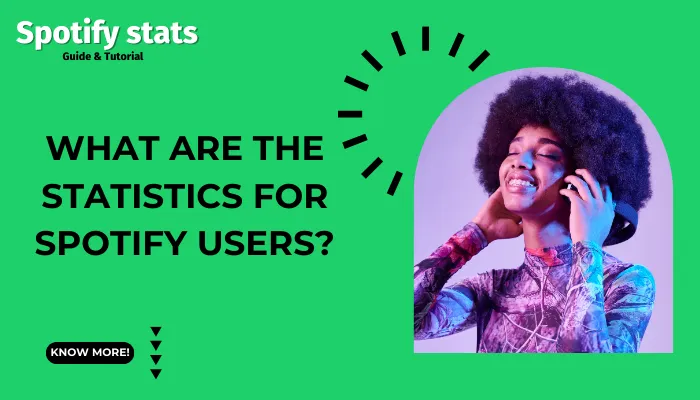Do you keep asking yourself what are the statistics for Spotify users? Spotify has changed the music industry through its large user base and innovative streaming platform. Marketers want to understand Spotify statistics for users and music industry professionals as well as anybody interested in digital media consumption trends.

Total Number of Spotify Users
Ever wondered what are the statistics for Spotify users? Brace yourself because we are about to delve into the Spotify User Statistics with a bang, beginning with the general number!
- Global Reach: As of 2024, Spotify has over 615 million active users worldwide making it one of the largest music streaming platforms globally. This growth path has continued since its launch in 2006 which shows how much it is liked by many people.
- Historical Growth: Over time, the number of people who listen to songs on this platform has doubled from around 300 million in 2020 to about 615 million in 2024, representing an annual increase rate of 18%. Strategic expansions into new markets and constant improvement in algorithms for music discovery have helped drive this growth.
- Comparison with Competitors: Regardless of competition from Apple Music and Amazon Music, it still leads with the highest number of active users boasting a customer friendly interface that allows them access to a wide variety of tastes and preferences when it comes to music selection.
Demographic Breakdown
Spotify claims to be the largest audience, but who are they exactly? This segment examines Spotify’s demographics which include age groups, gender and even how listening preferences vary. Let’s take a look at people behind these tunes.
Age Distribution:
People aged between twenty-five (25) and thirty-nine (39) years make up majority at approximately 50% in terms total Spotify account holders. In order for these users to get the most out their musical selections they are offered playlists that they can subscribe to or recommendations based on their personal taste from all songs available on this platform.
The next group, aged between eighteen (18) and twenty-four (24) years comprises 20% of the users. In a mobile-first world, their preference for mobile streaming drives Spotify’s emphasis on seamless integration with smartphones and tablets.
Gender Diversity:
Over half of all users identify as men while women make up the remaining percentage above. This makes sense, considering that the playlist curations and marketing strategies have to be given much thought in order to cater for different target groups hence more inclusive across different demographics.
Geographical Usage
Spotify has a huge global following, but what are the statistics for Spotify users? This section will examine the geographic distribution of Spotify users per region, identifying which parts of the world have the highest consumption and how that affects subscriber numbers.
Top Countries by User Base:
The US has the highest number of users followed by Nigeria and Indonesia. Regionalized music discovery efforts in these regions are favored by Spotify’s collaboration with local artists as well as localization strategies.
Regional Variations:
Europe is where Spotify has its largest user base including countries like Sweden, UK, and Germany where streaming is part of daily routines and cultural events. Spotify’s popularity in these areas is also enhanced through collaborative playlists featuring locally curated content.
Asia Pacific has witnessed growing adoption particularly in markets such as India and Australia which are driven by smartphone penetrations and improved internet services. Spotify’s partnership with telecoms companies coupled with content that is specifically designed to fit the needs of these emerging nations are some factors fueling this growth.
Device Preferences
Do you sometimes think about which device rules the roost in your auditory empire? We will employ Spotify statistics to uncover your preferences on a device. This part will take you through where you listen to music at high volume and show the tools that provide the soundtrack of your life.
Mobile vs. Desktop vs. Smart Speakers:
The majority prefer using their phones when accessing any media allowing them to listen to songs while moving around and doing other staffs.Thus, mobile optimization makes it easier for such people by availing intuitive navigation experience that comes along offline playback alternatives that gives out a user friendly environment helpful for them so they can’t be bored.
Desktop computers have been around for a while and they are still being used by some people even for music playback. Spotify desktop application enables the creation of collaborative playlists, editing them as well as sharing them on social media platforms.
The rise of smart speakers account for approximately 20% of streaming hours as the world is shifting towards voice-activated music control in homes and offices. This implies that hands-free control, personalized music recommendations based on listening habits, and integration with virtual assistants make it easy to use.
Listening Habits and Preferences
Have you ever thought about what Spotify thinks about you? or what are the statistics for Spotify users? We all have our favorite songs that we play over and over, little-known genres that we are obsessed with, and some really embarrassing music from the past. Using the statistics of Spotify, let’s go deeper to uncover a captivating world of your private listening choices.
Average Hours Spent:
For example, users spent an average of 2 hours per day on Spotify; this indicates a lot of engagement where the company personalized playlists as well as recommended tracks. There is also the Discover Weekly feature which makes use of algorithms in order to recognize individual preferences hence leading to extended sessions and revisiting.
In addition, about 25% engage with Spotify while they are commuting during its offline mode which allows them to access a customized offline curated playlist.
Popular Genres and Artists:
Nevertheless, pop music (including hip-hop) has remained dominant globally with artists such as Drake, The Weeknd, and Taylor Swift topping charts. These genres cater for diverse listener tastes and drive global music trends, thereby influencing editorial content generation at Spotify as well as suggesting particular lists.
Subscription Models
Though it has millions of active users, subscriptions are what really propels Spotify’s growth. We will try to understand different types of subscription models that Spotify uses to change listeners to paying fans and ensure the music keeps on playing.
Free vs. Premium Users:
However, only 35 % of Spotify users subscribe to the free ad-supported model which offers curated playlists that have occasional ads within them. Within such an arrangement therefore artists will be paid from advertisement impressions sold through the platform besides creating content that will eventually benefit them.
Another option is for individuals who decide to pay their way out such as through purchasing premium subscriptions that cost $9.99 each month thus enabling one to listen without any interruptions caused by adverts or stream even when offline. As a result, this stream of revenue helps to sustain the platform while it continues to improve and to introduce special offers for its subscribers.
User Engagement Metrics
We will look into some user engagement metrics that are vital in determining whether listeners interact with your content, therefore giving you a hint on their interests and hence enabling you to come up with a proper strategy for success on Spotify.
Daily Active Users (DAU) and Monthly Active Users (MAU):
Specifically, in 2021, Spotify reported 190 million DAUs and 230 million MAUs implying that many people still use some of its features like discovering content. In detail, such indicators show that individuals regularly utilize this website when searching for audio tracks which they love hence confirming its position among popular streaming companies.
Retention Rates:
Every week large numbers of users visit back Spotify once more indicating that it is sticky enough by providing good user interface tricks together with amazing retention strategies that work efficiently.
Conclusion
Now you have answer to question what are the statistics for Spotify users. Spotify has a massive fan base which includes both users with free and premium accounts. This is because it currently has over 600 million monthly active subscribers and its available options of music streaming, audio books, and podcasts are just limitless.
Consequently, even in this increasingly competitive world of digital audio streaming services, Spotify remains a key player. These statistics outlined here about the users can give you an idea to who is on Spotify as well as how they use it and what it means for their target group.
